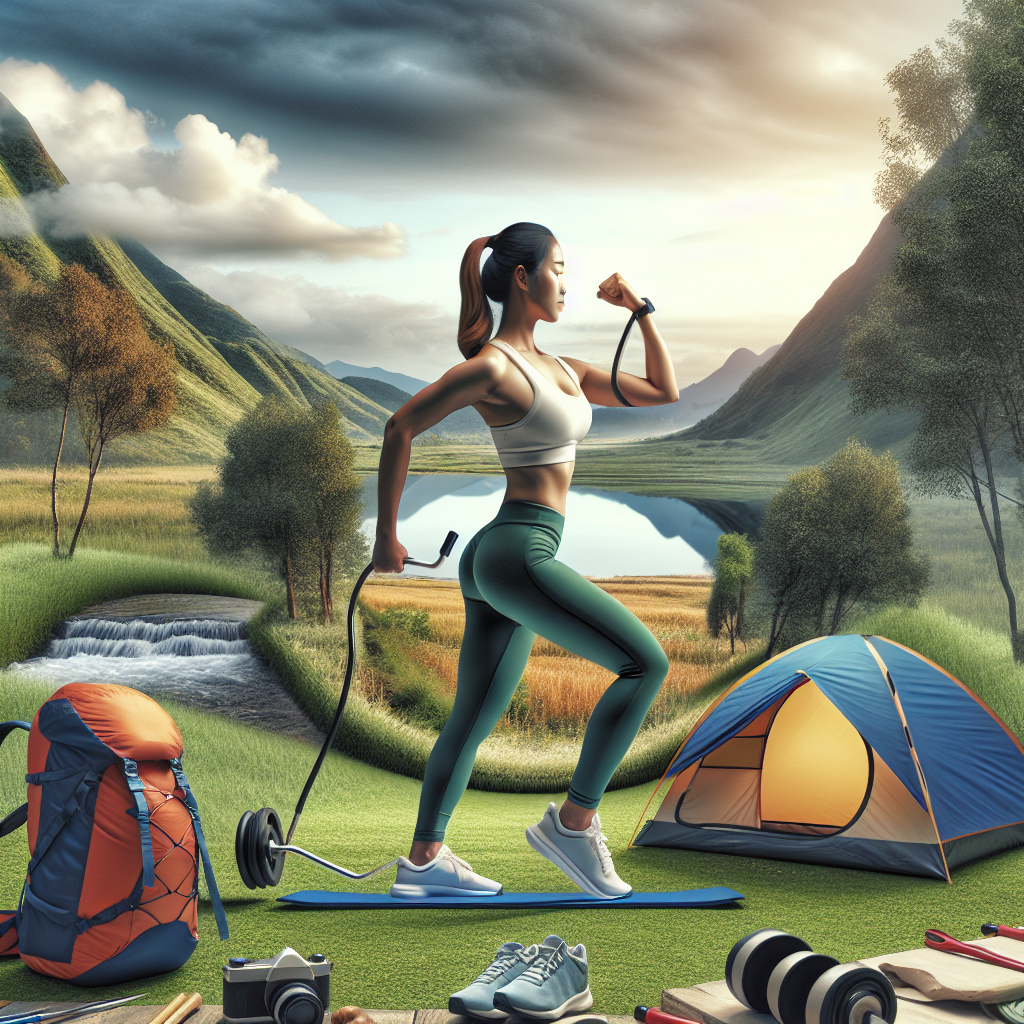Embarking on an intensive camping trip can be a thrilling experience, full of breath-taking wilderness encounters and unforgettable moments under the starlit sky. But, it’s important to remember that these outdoor adventures can also present a unique set of physically demanding challenges. In this light-hearted guide named “Fitness Preparation For Intensive Camping Trips”, you will find a thorough rundown of how to condition your body to meet these challenges head-on. Filled with practical workouts, nutritional tips, and expert advice, this article ensures that you’re fully prepared, both mentally and physically, for your next big outdoor escapade.
Understanding the Physical Demands of Camping
When you initially think of camping, the first things that likely come to mind are campfires, stargazing, and toasting marshmallows. However, one crucial aspect that often gets overlooked is the physical aspect of camping. It’s important to be aware that camping trips can bring about various physical challenges, whether it’s setting up tents, hiking, canoeing, or even just walking with a heavy backpack.
The physical challenges of camping
Camping involves many physically demanding activities and challenges. It requires strength and endurance, whether you’re backpacking in the wilderness or simply light camping at a designated campsite. For instance, setting up tents, carrying heavy gear, chopping or collecting firewood, walking or hiking on uneven terrain are all part and parcel of the camping adventure. Also, depending on the campsite location, you might find yourself dealing with altitude changes, strong winds, or cold temperatures—all of which can make simple tasks much more difficult.
How fitness contributes to a successful camping experience
Physical fitness is vital in ensuring you get the most out of your camping experience. Low fitness levels can restrict your ability to fully participate in camping activities and can even lead to potential health risks in the wilderness. The fitter you are, the more you can enjoy the activities that come with camping, including hiking, canoeing, climbing, or swimming. In essence, a higher fitness level contributes to a more rewarding and less physically stressful camping experience.
Activity-specific preparation for camping trips
Preparation is key when it comes to camping. Having a clear picture of what activities your camping trip will entail will enable you to prepare adequately. If you’re going to be hiking or mountain biking, for instance, spending some time on the bike or walking in the lead-up to your trip will be beneficial. Similarly, if your camping trip involves canoeing or kayaking, working on your upper body and core strength will be valuable in preparing you for such tasks.
Assessing Your Current Fitness Level
Before diving into a new workout routine to prepare for your camping trip, it’s essential to understand your current fitness level. This will ensure that you start at the right place, avoid injuries, and continue to make progress throughout your training.
How to self-evaluate your fitness
There are several ways to self-evaluate your fitness level. You could use standard fitness tests such as push-ups, sit-ups, squats, and walking or jogging for a specified time or distance to get a sense of your strength and endurance. This will provide an indication of your current fitness level and where you need to focus your efforts.
Seeking professional fitness assessment
In case you’re not sure about self-evaluating your fitness level, you can seek professional help. Personal trainers, physiotherapists, and other fitness experts can assess your current fitness level, strength, flexibility, endurance, balance, and overall physical abilities. It’s a great way to ensure that your training regimen is tailored to you and safe for your current fitness level.
Relating your fitness level to camping activities
After understanding your current fitness level, it’s important to relate your findings to the activities you’d be involving yourself in during camping. Can you carry a heavy load over a long distance? How about paddling a canoe or climbing a hill? These are some of the areas you need to consider during your fitness evaluation as they’ll inform the type of training you need in preparation for your camping trip.

Developing a Suitable Fitness Plan
Drawing up a fitness plan is an essential part of your camping trip preparation. You should aim to improve your cardiovascular conditioning, build strength, and increase flexibility through a balanced and comprehensive workout plan.
The role of cardiovascular conditioning
Cardiovascular conditioning plays an integral role in your overall fitness. Activities such as hiking, setting up camp, and exploring surrounding areas could have you breathing hard, especially if you’re at a high altitude. By focusing on cardiovascular training, you can increase your body’s ability to use oxygen, which will help you handle these strenuous activities and recover quicker.
Strength training for camping preparation
Strength training should be a vital part of your fitness plan. From carrying heavy backpacks and gear to setting up tents and climbing, camping activities require a significant amount of strength. By incorporating strength training into your regimen, you can increase your muscle power and endurance, which will make these tasks more manageable.
Flexibility exercises to prevent injury
Flexibility exercises are crucial in preventing injuries during your camping trip. They help improve your range of motion and balance, which are particularly useful when navigating uneven terrains, climbing, or setup camp. Including stretching routines and exercises like yoga or Pilates can significantly enhance your balance and flexibility.
Creating a balanced and encompassing workout plan
When developing a fitness plan for camping, it’s vital to strike a balance between different types of exercises. You need cardiovascular exercises for stamina, strength training for power and endurance, and flexibility exercises for balance and injury prevention. The plan should include a mix of these tailored to your current fitness level, ensuring you improve gradually without pushing yourself too hard too soon.
Integrating Recreational Activities into Workout
Turning your favorite outdoor activities into workouts is a fun and effective way of increasing your fitness level for camping. By participating in sports or other outdoor hobbies, you can improve your fitness while enjoying the process. It’s also an excellent way to prepare for specific camping activities.
Turning outdoor hobbies into workouts
Do you enjoy swimming, biking, running, or playing sports like soccer or basketball? These activities can become your workouts. They combine fun with fitness and get you into the great outdoors, so they feel less like work and more like play. They’ll also help you build stamina, strength, and flexibility in a more relaxed and enjoyable way.
Beneficial sports activities for campers
Certain sports can be particularly beneficial for campers due to the variety of physical skills they require. Sports like rowing or paddling can improve your strength and stamina, while activities like trail running or mountain biking can prepare you for steep or uneven terrain. Swimming is another great option for general fitness and, if it’s going to be part of your camping trip, increasing your confidence and skills in the water.
Preparing for specific camping activities
If you know the activities your camping trip will involve, you can tailor your workouts to prepare for these. For instance, if you’re going to be doing a lot of hiking, spend some time walking or running on different terrains. If your trip will involve rock climbing, focus on strengthening your arms and core with exercises like pull-ups or planks.

Nutrition for Fitness and Intensive Camping
With all this focus on physical preparation, it’s equally important not to overlook the role of nutrition in fitness and camping. The foods you eat will fuel your workouts, recover from them, and keep you energized during your trip.
Fueling your body for exercise
You need to fuel your body with the right nutrients to get the most out of your exercises. Carbohydrates are your body’s preferred energy source during high-intensity workouts, so include plenty of whole-grain foods in your diet. Protein is crucial for muscle recovery and growth, so make sure you’re getting enough from sources like lean meats, dairy products, or plant-based alternatives.
Balanced diet for camping preparation
As you prepare for your camping trip, it’s important to maintain a balanced diet. This means including a variety of foods from all food groups—carbohydrates for energy, proteins for muscle repair, fats for long-term energy storage, and vitamins and minerals for overall physiological function. Prioritize nutrient-dense foods over processed food items to ensure your body is well-nourished.
Nutrition planning during the camping trip
When you’re on your trip, you’ll need extra energy to cope with the increased physical activity and colder outdoor temperatures. Pack nutritious snacks like nuts, seeds, and fresh fruits, and consider meals rich in protein and carbohydrates. You should also plan for warming foods, such as soups or hot beverages, if you’ll be camping in cold weather.
Hydration for Fitness and Outdoor Activities
Hydration is another key component of fitness and outdoor activities. Staying optimally hydrated is vital for overall health, exercise performance, and recovery. During your camping trip, it’s essential to manage your hydration levels to avoid dehydration or over-hydration.
Importance of hydration
Staying hydrated aids in essential bodily functions and maintains your body’s balance of bodily fluids. It helps manage body temperature, lubricate joints, transport nutrients, and much more. During vigorous physical activity like camping, you’ll likely lose fluids through sweat and need to replenish these by drinking enough water.
Drinking guidelines during exercise
As a general rule, you should aim to drink about half a liter of water for every 30 minutes of intense exercise. However, these amounts can vary depending on the intensity of the activity, the weather, and individual differences. Pay attention to your body signals of thirst, and monitor the color of your urine—it should be light yellow, a sign of proper hydration.
Managing hydration while camping
While camping, carrying large amounts of water may not be practical. You can explore options such as packing a portable water filter or purification tablets. Always have a water source in mind when choosing a campsite and remember that activities at altitude or in hot weather will increase your need for water so plan accordingly.
Fitness Training Program Suggestions
Once you’ve assessed your physical fitness and understood the physical demands of camping, you can start constructing a fitness program tailored to your needs. This should ideally cover cardiovascular, strength, and flexibility training.
Workout programs for cardiovascular improvement
For cardiovascular training, consider workouts that increase your heart rate. Activities such as running, cycling, swimming, or using equipment like the treadmill, stair climber, or elliptical machine are effective. Start with low to moderate intensity, then gradually increase as your fitness improves. You can also consider incorporating interval training for added fitness gains.
Strength training routines
Strength training routines should focus on your legs, back, shoulders, and core—muscles you’ll use a lot when camping. Exercises like squats, lunges, push-ups, planks, or pull-ups can be especially beneficial. You can use weights, resistance bands, or your own body weight. Just like with cardio, start with light activities and then gradually increase intensity.
Guidelines for flexibility and balance training
Flexibility and balance training can include static stretching, dynamic stretching, yoga, or Pilates. These sessions, particularly post-workout when your muscles are warm, can help improve your range of motion, reduce muscle tension, and enhance balance and stability. Aim for at least two flexibility and balance sessions per week.
Injury Prevention and Safety Measures
When increasing your fitness level and participating in outdoor activities, injury prevention and safety are paramount. By recognizing common injuries, using proper gear, and having first aid skills, you’ll be well-prepared to avoid and handle incidents.
Recognizing and avoiding common injuries
The most common camping injuries come from falls, cuts, burns, and strains or sprains from lifting or overexertion. Pay careful attention when moving around, especially on uneven terrain, when handling knives or other sharp tools, and dealing with fire. Also, make sure to lift heavy items properly and not to push yourself too hard during your workouts to avoid strains and sprains.
Proper gear for protection
Choose the right gear for your activities. Wear footwear that provides good support and protection, dress in layers to manage temperature changes, and use equipment like a helmet for biking or gloves for climbing when needed. Bringing along a first aid kit that includes bandages, antiseptic wipes, tweezers, and over-the-counter pain medication is also a must.
First aid skills and preparation
Having basic first aid skills can be a lifesaver in case of an incident. Knowing how to treat cuts, burns, and sprains or how to perform CPR can be immensely beneficial. There are many first aid courses available, including some specifically designed for outdoors or wilderness scenarios.
Implementing a Progressive Training Regimen
When starting or leveling up a fitness training plan, it’s crucial to take a progressive approach. This means setting realistic goals, gradually increasing workout intensity, and adapting your program as your fitness improves.
Setting realistic goals
Your training goals should be specific, measurable, achievable, relevant, and time-bound (SMART). For instance, rather than saying you want to build strength, you might set a goal to be able to lift a certain weight or do a set number of strength-based exercises in a particular timeframe.
Gradually increasing workout intensity
Increasing workout intensity too quickly can lead to injury. As you become stronger and your endurance improves, gradually increase the intensity of your workouts. This could mean lifting heavier weights, incorporating more challenging movements, or extending your training sessions.
Adapting your program according to progress
As your fitness improves, continually adapt and modify your training program to ensure it remains challenging and relevant to your camping activities. This could include incorporating new exercises or focusing on specific areas where you feel you need to improve.
Post-Trip Fitness Maintenance
After a successful camping trip, it’s time to focus on recovery and maintaining your fitness level. This can help you return to your daily activities more quickly and prepare you for your next camping adventure.
Recovery strategies after intensive camping
After your camping trip, it’s important to allow your body time to recover. This might involve light exercises like stretching or yoga, getting sufficient sleep, staying hydrated, and eating nutritious meals. If you experience any pain, swelling, or decreased mobility, seek medical advice.
Continuous fitness strategies for regular campers
If you’re a regular camper, maintaining fitness is key. Keep up with your cardio, strength, and flexibility training so you’re always ready for your next trip. Remember to cross-train to prevent overuse injuries, and keep your routines varied and enjoyable to stay motivated.
Appreciating your physical improvements and achievements
Take time to appreciate the progress you’ve made and the physical achievements you’ve accomplished. Not only have you prepared yourself for the physical challenges of camping, but you’ve also adopted a healthier lifestyle, which is genuinely something to celebrate. The strength, endurance, and resilience you’ve built will serve you well in all areas of your life. Remember, the journey matters as much as the destination, and each step you take toward better fitness is a victory in itself.

